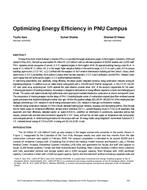Description
Princess Nora Bint Abdul-Rahman University (PNU) is currently the largest construction project in the Kingdom. Initiated in 2009 and opened in May 2011, the built-up area totalled 30 million ft2 (2.8 million2) with an ultimate population of 40,000 students and 12,000 staff. PNU represents almost one-quarter of current LEED registered projects in the Kingdom. With 38 separate buildings having a total BUA in excess of 11 million ft2 (1 million m2), it is the largest higher education facility in the world to target LEED on such a scale. All its campus buildings aspire to be LEED NC v.2.2 Certified with the exception of: the Female Administration building and the Central Library, which aspire to be LEED Gold certified, the Academic Campus which has been awarded LEED Gold Certification, and the PNU Medical Center and Hospital that will be the world’s largest LEED certified healthcare facilities.
In optimizing sustainability and, specifically, energy efficiency, the design process integrated numerous energy conservation measures among all engineering disciplines. In addition to an air cooled district cooling plant with a 100,000 ton-hr thermal storage tank, a 391,171 ft2 (36,341 m2) solar panel array comprising over 3,600 separate flat plate collectors provides about 10% of the campus’s requirements for hot water. Following optimization of building orientation, the envelope is designed to demonstrate an energy efficient response to a harsh and challenging arid climate. The curtain wall system includes high performance vision glazing and insulated shadow-box construction at column and spandrel zones. The incorporation of shading strategies into the design of PNU’s building facades consist of musharabiah-inspired glass fibre reinforced concrete panels and screens that shade the building from direct solar gain. Within the academic colleges, 861,000 ft2 (80,000 m2) of this shading has been deployed, contributing a 3.5% reduction in overall energy consumption and a 13% reduction in heat gain on the exterior envelope.
Additional energy conservation measures (ECMs) include: decreased lighting power densities, occupancy and day-lighting controls, blow through fans for higher supply air temperature differential, demand control ventilation (DCV), variable frequency drives (VFDs) on all equipment, high equipment and motor efficiencies, dedicated outdoor air system (DOAS), underfloor air distribution in auditoriums, evaporative cooling, heat recovery, pressure reset and dual-maximum-control sequence for VAV boxes, and last but not least supply air temperature reset during winter and unoccupied periods. A whole building simulation for the campus with over 30 energy models using Integrated Environmental Solutions IES VE indicated annual savings of 17.6 to 25.6% in energy and 16.3 to 22.8% in cost.
Citation: International Conference on Efficient Building Design, Materials and HVAC Equipment Technologies; October 2-3, 2014; Beirut, Lebanon
Product Details
- Published:
- 2014
- Number of Pages:
- 10
- File Size:
- 1 file , 1.6 MB
- Product Code(s):
- D-ICEB14-21




